Producers are facing constant challenges relating to weather and environmental stressors, and whether it’s wind, disease, or a lack of moisture it’s hard to fight mother nature.
Kui Liu, an agronomy research scientist at Agriculture and Agri-Food Canada (AAFC), has been testing a varietal mix of barley to be used as livestock feed and a mitigation for difficult environments.
Follow all our Ag in Motion coverage here
Read Also

Trump’s tariffs take their toll on U.S. producers
U.S. farmers say Trump’s tariffs have been devastating for growers in that country.
This research project is being showcased at Ag in Motion 2025 near Langham, Sask., at the AAFC booth alongside other trials and research displays by AAFC. In the barley plot, there are four varieties in the mix: CDC Austenson, AAC Lariat, AB Wrangler, AAC Bell.
However, Liu warns he can’t tell the difference between them, saying with a laugh that he’s an agronomist, not a breeder.
But he can explain the benefits of using a variety mix such as this one.
By having different varieties of the same species, it allows for the targeting of different issues such as lodging, disease, drought, and pests. It also assists in increasing above- and below-ground functional diversity, and improves available ecosystem services to increase yield.
“I think if you diversify your cropping system, you might improve the stability, particularly under the stressful environments,” he said. “So, in a good environment, you do not need to diversify your system, but in a stressful environment, when you diversify your cropping system because different crops have different traits, they may have different ability to cope with the stress.”
Liu has chosen to include varieties to address the various growing challenges. Some are disease resistant, drought resistant, pest resistant, or lodging resistant, as a result no matter what the conditions there should be a strong overall crop. The goal of the trial is to identify what the best variety mix and ratio is for addressing the issues, as well as best yields, so they can offer producers a reliable recommendation.
“If the mixture is better than the pure stand, we want to know how to establish or select the traits to mix them together,” he added. “Some traits maybe have a dominant role in the mixture, others may play a minor role. So, we are trying to quantify the contribution of each variety to the like overall mixture.”
And in comparison to other intercropped feed blends, this trial has much easier management practices. Even though it’s a blend, Liu can treat the entire plot if it’s a pure stand making it much simpler to utilize herbicide, fungicide, and fertilizer treatments since tolerances are the same.
This is also helpful when it comes to the harvesting process.
“It’s straight forward. It’s almost like the a single crop, because they’re maturity dates are quite close.”
















